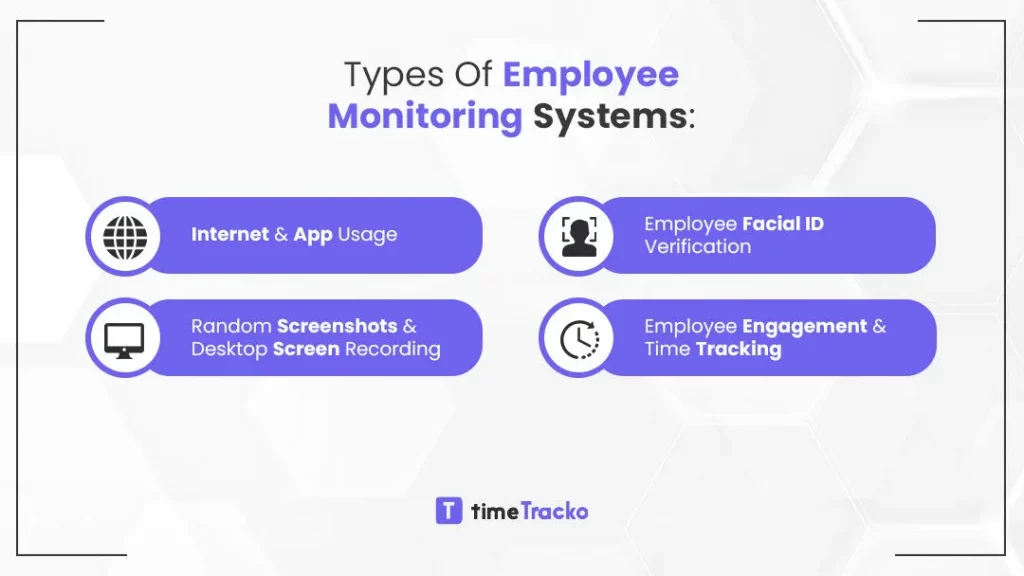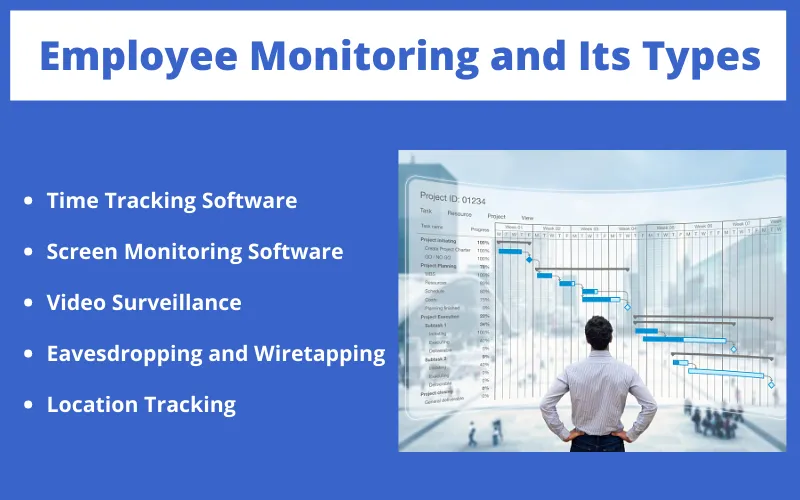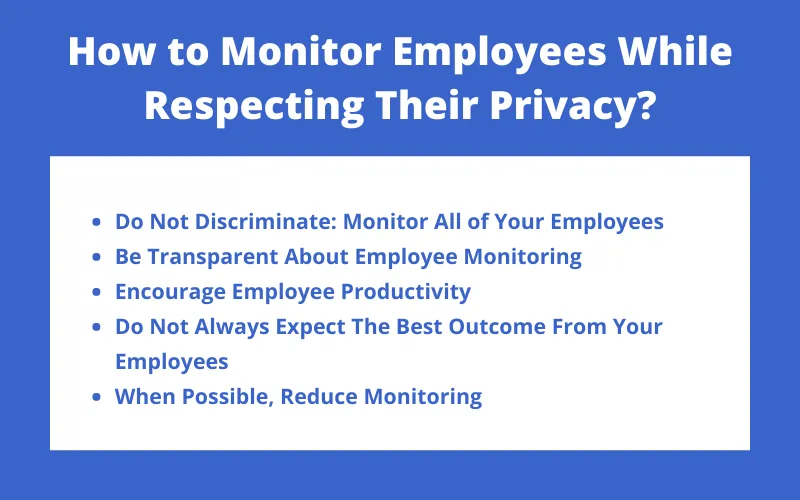Is Employee Monitoring a Productivity Enhancer or a Privacy Killer?
Is Employee Monitoring a Productivity Enhancer or a Privacy Killer?
Transparency is always a good practice when it comes to employee monitoring. Since many employees feel uncomfortable being monitored, it’s important to be forthcoming about what you hope to accomplish and how surveillance aligns with your business’s goals.
This way, you can monitor your employees without worrying about invading their privacy.
Employee Monitoring Software
Employee monitoring software is a useful tool for performing a delicate check on staff performance.
The monitoring software can effortlessly track and control employees’ activity without feeling the pressure of a manager or supervisor constantly watching their actions.
Employee monitoring and time tracking software can monitor the workers’ activities in real-time.

Each team member can see what each other is doing right now, which websites they visited, and what apps they used.
In addition to this, you can set the system to generate an immediate alarm if any employees violate specific rules.
Remote employee monitoring is effortless with the monitoring apps. You can get remote PC access and set individual settings for each employee depending on their jobs.
Employee Monitoring software analyses and creates the staff’s activity and productivity reports for you.
There is a variety of employee monitoring software available on the software market. Business leaders have a wide choice, allowing them to make the best choice for their company.
Is It Legal to Monitor Your Employees?
Increasingly, businesses are considering employee monitoring software regarding insider thefts, fraud, inefficiency, and inappropriate behavior at work.
There are higher chances of creating many new concerns when protecting from external threats since this is not the standard practice.
The monitoring of employees is, therefore, legal. As per federal law, monitoring employees is legal.
Making your monitoring practices transparent helps your employees feel more secure and protects your company from legal action.
Employers should notify their employees about their monitoring services and mention these policies in their employee handbooks.
Employees may be deterred from violating company policies by being informed of their supervisor’s rights.
Many people can become more aware of their surroundings by actively monitoring their colleagues.
Despite this, the cost of data breaches, internal attacks, fraud, sexual assault, bullying, cyber threats, etc., is rising rapidly today.
Employee Monitoring: Why Do Employers Do It?
Increasingly, business leaders are using various types of employee monitoring software and surveillance to take a closer look at their employees’ work activities while on the clock.
It is common for large companies to track employees’ emails, phone calls, and keystrokes.
In a time of crisis, companies take such decisions primarily to protect their business and increase the productivity of their employees at work.
In the workplace, the most prevalent issue is the misuse of working hours. When employers don’t watch their employees, they spend their office hours doing more unproductive tasks.
Your staff might waste time in their business, scrolling their Facebook and Instagram feeds every 2-3 minutes throughout the working hours.
Some staff spends their time reading the news and checking their mail every day.
I bet every office has employees who text and chat on their mobile phones or even their computers when no one is watching them.
Watching Youtube and checking different social media platforms is the most common practice.
If you include the employees who are usually late to work or leave early, you get wasted time. I wonder if every company has frauds?
These actions often result in serious company losses or even shutting down. Thus, companies monitor their employees using time tracking and employee monitoring software.
Employee Monitoring and Its Types

Business leaders employ different types and techniques of employee monitoring to prevent misuse of working time and increase safety.
Employers watch their employees in various ways. Some of the most popular ones include:
Time Tracking Software
Businesses use the best time tracking software to keep track of their employees’ office time. Using time tracking software, they can track every minute of their employees.
They can estimate and know the time required to complete a project and whether it gets completed within the available timeframe.
When you install time tracking apps on all the devices your employees use for work, you can see the productive time, idle time, break times that your employees take, etc.
Screen Monitoring Software
Computer activity tracking software is usually used for tracking employee activities on the screen.
Users can see which apps they are using, how fast and accurate their entries are, the amount of time away from the computer, and how much traffic appears and disappears on the company network.
Also, employers can see screenshots of what employees are working on. If you think any of your employees are doing something suspicious on their computer, you can immediately track their activity and see if they are doing something inappropriate.
Video Surveillance
Many companies keep all their employees under video surveillance to watch everyone’s activities. Video monitoring helps managers to track employees’ behavior.
They can easily track if someone is physically harassing the other. Also, they will instantly know if some staff do unethical things in the office.
By installing visible and secret cameras in the workplace, one can also scare off bad activities like theft.
Eavesdropping and Wiretapping
Not all offices do this, but some employ this method to monitor conversations with customers.
When they hear the conversations with customers or external entities, they can instantly track if someone aims for data or private information leakages.
Wiretapping provides better service and also prevents divulging sensitive information outside the company.
Location Tracking
Location tracking is not a more common employee monitoring practice; however, companies track employees’ location via several methods. In some cases, it tracks location via the employee’s device’s GPS tracking.
Companies also have electronic sensors and locks installed at the doors. They monitor their employees coming in and going out of the office.
Monitoring prevents unauthorized people from entering the office and stops employees from going inside when it’s not their office time.
How to Monitor Employees While Respecting Their Privacy?

Do Not Discriminate: Monitor All of Your Employees
It is easy to judge other people and make some quick judgments. Unnecessary surveillance judgments can affect both the employer and the employees. So, employers should keep relevant information on employee productivity and efficiency.
Watching your employees is fine, as long as the information you track is relevant and necessary.
It is essential to reach both new and experienced employees and give their input without fear of retribution to increase employee engagement.
Be Transparent About Employee Monitoring
Communication is an essential element of respect for someone, as is being open and honest with them. Make sure you explain why you are monitoring your employees. Could you encourage them to offer feedback?
They should be informed about the monitoring results and a system to appeal to any career decisions influenced by the data collected.
Employees are more willing to accept transparency. Not all employees are comfortable with their employers monitoring their email.
But if the employer explains why they are monitoring the employees, employees will feel more comfortable.
When your employees are comfortable with employers watching them, they will become more productive. And employees will not feel insecure about employers invading their privacy.
Encourage Employee Productivity
Using employee monitoring software in offices boosts employee productivity. Also, when employees feel that their boss is watching their screen, they will work more effectively.
When they fear that their manager is watching them, they will not perform activities that can cause harm to the company.
Please think about motivating your employees by rewarding their hard work or finding ways to help them be more productive.
In addition, you should think about ways of motivating and boosting relevant numbers, not just focusing on ways to discourage inefficiency.
Do Not Always Expect The Best Outcome From Your Employees
Accept the fact that excellent workers cannot always perform excellent work. People are sometimes judged by their performance to determine whether they are good or hard workers.
Some talented and hard-working employees may be stretched extraordinarily thin for personal reasons. People like these are the ones you want to keep since they add a great deal of value in the long run.
A successful conversation should understand the employee’s situation and consider creative solutions, not threats.
When Possible, Reduce Monitoring
Particularly in these times, monitoring is understandable. However, many people will be returning to their offices shortly — and some may continue to work from home — and monitoring efforts can be reduced where things are going well.
The employees will see this as a sign of trust. In addition, it helps correct the tendency to gain more control than necessary when circumstances are not as extreme as they once were.
Your employees are your most valuable assets. You cannot replace their institutional knowledge or skills, and it’s costly to replace them as you’ve spent time and money on them.
Companies should treat their employees with respect not just because they deserve it but also because retention depends on it.
If you decide to implement surveillance software at your company in this climate, you should remember that you are not the police. Monitoring can be done with an outstretched hand, not a raised baton.
Monitoring Employees: Pros and Cons
Advantages of Employee Monitoring
- Time tracking. You can keep track of the time your employees spend on individual tasks and projects.
- Employees are given a time estimate for every specific task as well as how much time they need;
- Checking whether the employees follow safe practices or not.
- You can spot and reveal harassment and other uncomfortable activities at the office.
- Increased privacy. You can instantly watch if someone is exposing your crucial and sensitive business-related information to outsiders.
- You can watch customers’ interactions with employees. You can use this to evaluate your workers’ performance and ask them to improvise when needed.
- Project Management. When you can watch everything going on in a project, you can evaluate and make changes to factors like the project completion deadline, the number of additional employees needed in the project, the resources to be added, etc.
Disadvantages of Employee Monitoring
- Privacy concerns. Workers may feel their privacy is at risk by using the monitoring tools.
- The breakdown of trust. Monitoring tools can be seen as an indication that an employee is distrustful. The result may be a toxic work environment and high turnover rates.
- Fraudulent use of data. There is a risk of misuse of the accumulated personal data due to the abundance of information.
- Legal matters. Whenever an employer conducts surveillance, it is important to ensure that it does not violate local, state, or national laws.
Conclusion
While employee-monitoring practice is beneficial, it can have numerous drawbacks if misused. For this reason, business owners need to choose the tools they use to monitor employees carefully.
Furthermore, it is a must that they properly implement their systems. Employees should also be aware of all the benefits it offers to them and the company and should not regard it as spying or a signal of suspicion.

 in Melbourne
in Melbourne 
 Employee Screen Monitoring Software
Employee Screen Monitoring Software App and Website Monitoring Software
App and Website Monitoring Software Time and Attendance Software
Time and Attendance Software Finance
Finance Banking
Banking Healthcare
Healthcare Lawyers
Lawyers Retail & ecommerce
Retail & ecommerce Knowledge base
Knowledge base Blogs
Blogs Installation Guide
Installation Guide FAQs
FAQs About
About Media Kit
Media Kit Contact us
Contact us